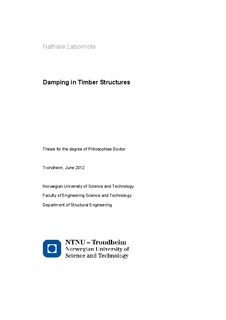| dc.description.abstract | Key point to development of environmentally friendly timber structures, appropriate to urban ways of living, is the development of high-rise timber buildings. Comfort properties are nowadays one of the main limitations to tall timber buildings, and an enhanced knowledge on damping phenomena is therefore required, as well as improved prediction models for damping.
The aim of this work has consequently been to estimate various damping quantities in timber structures. In particular, models have been derived for predicting material damping in timber members, beams or panels, or in more complex timber structures, such as floors. Material damping is defined as damping due to intrinsic material properties, and used to be referred to as internal friction. In addition, structural damping, defined as damping due to connections and friction in-between members, has been estimated for timber floors.
The thesis consists of six main parts. The first part is entitled “Contexts”, and is composed of four chapters. A general overview of the wood material and its structural use in buildings is presented in Chapter 1. Chapter 2 gives a thorough literature review on comfort properties of (timber) floors. Chapter 1 and Chapter 2 serve as justifications for the motivation of this work, expressed in Chapter 3, and the aim of the work, expressed in Chapter 4.
The next part “Backgrounds” briefly describes the basic theories used along the thesis, for the analytical studies (Chapter 5), the experimental studies (Chapter 6), and the numerical studies (Chapter 7). The part “State of the art” is a general literature review on damping (Chapter 8). A particular accent is set on the derivation of various damping prediction models.
The “Research” part summarizes the original research work. Chapter 9 briefly presents the background and main findings for each study, and Chapter 10 concludes and proposes suggestions for further research.
The studies are detailed in four journal papers, which are integrally reported in the “Publications” part.
Paper I focuses on the evaluation of material damping in timber beam specimens with dimensions typical of common timber floor structures. Using the impact test method, 11 solid wood beams and 11 glulam beams made out of Norway Spruce (Picea Abies) were subjected to flexural vibrations. The tests involved different spans and orientations. A total of 420 material damping evaluations were performed, and the results are presented as mean values for each configuration along with important statistical indicators to quantify their reliability. The consistency of the experimental method was validated with respect to repeatability and reproducibility. General trends found an increasing damping ratio for higher modes, shorter spans, and edgewise orientations. It is concluded from the results that material damping is governed by shear deformation, which can be expressed more conveniently with respect to the specific mode shape and its derivatives.
Paper II deals with the prediction of material damping in Timoshenko beams. Complex elastic moduli and complex stiffness are defined to derive an analytical model that predicts the hysteretic system damping for the whole member. The prediction model comprises two parts, the first related to bending, and the second related to shear. Selected experimental damping evaluations from Paper I are used to validate the model and obtain fitted values of loss factors for two types of wood. The good agreement of the derived model with experimental data reveals an efficient approach in the prediction of material damping.
In Paper III, a semi-analytical prediction model of material damping in timber panels is described. The approach is derived from the strain energy method and input is based on loss factors, which are intrinsic properties of the considered materials, together with material properties and mode shape integrals, whose calculation can easily be implemented in most finite element codes. Experimental damping evaluations of three types of timber panels are performed. These are particleboards, oriented strand board panels and structural laminated veneer panels. Fair goodness-of-fit between the experimental results and the prediction models reveals an efficient approach for the prediction of material damping in timber panels with any boundary conditions, knowing only the loss factors and the mode shapes.
In Paper IV, dynamic properties of two timber floors are experimentally evaluated by impact method. Each floor uses one specified type of connectors, either screws or nails. A numerical model is developed using constrained degrees-of-freedom for the modeling of connectors. Numerical analyses have been performed, and show good agreement with experimental results. A procedure is written using the commercial finite element software Abaqus to predict material damping from a strain energy approach. Estimation of structural damping is performed as the difference between the experimentally evaluated total damping and the predicted material damping. The contribution from floor members to material damping is extensively investigated, and the needs for better prediction of damping are discussed.
Specific details of some aspects of the work are included in the “Appendix” part. | nb_NO |
